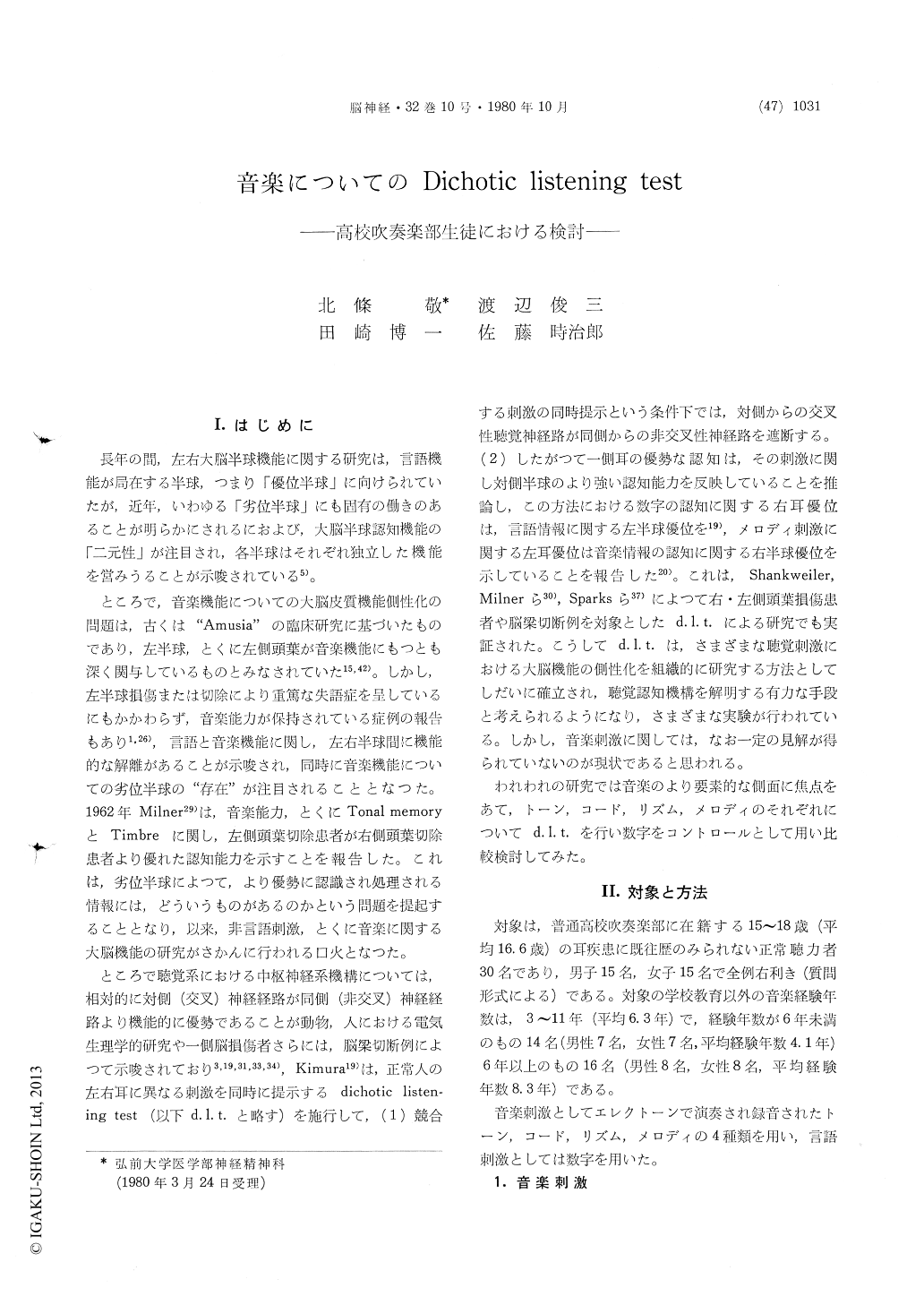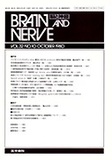Japanese
English
- 有料閲覧
- Abstract 文献概要
- 1ページ目 Look Inside
I.はじめに
長年の間,左右大脳半球機能に関する研究は,言語機能が局在する半球,つまり「優位半球」に向けられていたが,近年,いわゆる「劣位半球」にも固有の働きのあることが明らかにされるにおよび,大脳半球認知機能の「二元性」が注目され,各半球はそれぞれ独立した機能を営みうることが示唆されている5)。
ところで,音楽機能についての大脳皮質機能側性化の問題は,古くは"Amusia"の臨床研究に基づいたものであり,左半球,とくに左側頭葉が音楽機能にもつとも深く関与しているものとみなされていた15,42)。しかし,左半球損傷または切除により重篤な失語症を呈しているにもかかわらず,音楽能力が保持されている症例の報告もあり1,26),言語と音楽機能に関し,左右半球間に機能的な解離があることが示唆され,同時に音楽機能についての劣位半球の"存在"が注目されることとなつた。1962年Milner29)は,音楽能力,とくにTonal memoryと Timbreに関し,左側頭葉切除患者が右側頭葉切除患者より優れた認知能力を示すことを報告した。これは,劣位半球によつて,より優勢に認識され処理される情報には,どういうものがあるのかという問題を提起することとなり,以来,非言語刺激,とくに音楽に関する大脳機能の研究がさかんに行われる口火となつた。
30 right-handed senior high school students (15 males, 15 females belonging to the wind-instrument club) were tested in the recognition of five kinds of dichotically presented stimuli: originally recorded tones, chords, rhythms, melodies and digits. Thetests compared the abilities of each ear to recognize double auditory stimuli presented simultaneously to both ears.
1) The mean scores for the two ears in the Tones test were nearly the same. The Chords test, on the other hand, reveals a significant left ear superiority only for the male subjects. In the Rhythms test, the score for the right ear was significantly higher than for the left ; and in the Melodies test, the score for the left ear was signi-ficantly higher than for the right. A significant right ear preference was shown in the recognition of digit-stimuli, as previously established.
2) As for the sex differences, the left ear supe-riority was found in the recognition of chord- and melody-stimuli only for the male subjects. These findings suggest that the male subjects show greater "unilateral hemispheric superiority" not only for the verbal stimuli, but also for some non-verbal stimulus materials that seem to be more adapted for the right hemisphere. In other words, con-cerning the left-right hemispheric asymmetries, the equipotentiality for the female subjects was speculated.
3) As for the musical training, the left ear superiority was found in the recognition of melody-stimuli only for more trained subjects. These findings invite a speculation that the right hemi-sphere may develop a peculiar specialization for some kinds of non-verbal processing as the left hemisphere develops a specialization for speech processing.
4) From the point of stimulus-property, the left hemisphere was specialized for speech (Digits) activity, and for serial and analytic (Rhythms) processing incoming information, while the right hemisphere was more adapted for the perception of holistic and synthetic (Melodies) relations. Furthermore, the results of the individuals suggest that there are some differences between verbal (Digits) and non-verbal (Rhythms) processings, which are both predominantly specialized in the left hemisphere.

Copyright © 1980, Igaku-Shoin Ltd. All rights reserved.


